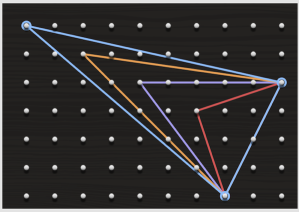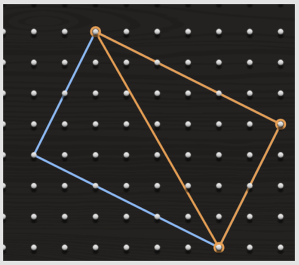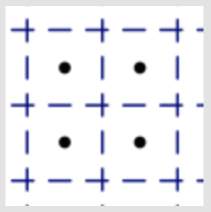At the San Francisco Math Teachers’ Circle yesterday (March 4, 2017), we explored four “teacher-level” geoboard problems (All can be adapted for classroom use.) Here is a brief report, including some spoilers, I’m afraid.
Pick’s Formula
It turns out that the area of a geoboard polygon can be figured out by counting the lattice points it contains (inside dots, and boundary dots), and combining these into a formula. Amazingly, this formula (known as Pick’s formula) works for any geoboard polygon (i.e. any polygon whose vertices are on lattice points.) Since few participants knew this formula, we devoted the first half of the meeting to figuring it out.
If you don’t know it, you can figure it out yourself. Download some dot paper here. For a hint, scroll past the spoiler space beneath my signature below.
A somewhat more guided discovery of the formula is in Lab 8.6 of Geometry Labs. (free download).
A proof of the formula, and some reflections about it, can be found on my Web site. Some of it is suitable for discussion with students after they found the formula, but most of it is geared to teachers.
Isosceles Triangles
Find isosceles triangles on the 11 by 11 standard geoboard. (No need to count triangles congruent to one you find, even if they are located elsewhere, or oriented differently.) There are many, many possible answers, so the problem gets more interesting if you add some constraints:
- exclude triangles whose base is parallel to the edge of the board
- exclude triangles whose base makes a 45° angle with the edge of the board
- exclude right triangles
- require the apex to be at the origin
…or any combination of those constraints.
One interesting strategy someone suggested was to start with a base whose midpoint is a lattice point, and to place the apex on its perpendicular bisector. As in these examples:

(One version of this problem, with answers in the back of the book, is at the end of Lab 9.2 in Geometry Labs.)
Triangles of Area 15
Find geoboard triangles of area 15 such that no side is parallel to the edge of the board. This problem is surprisingly difficult to solve by trial and error. I discussed it in a previous blog post, but the ideas that emerged yesterday were a lot more interesting than what I had come up with.
One excellent strategy was to find tilted geoboard rectangles of area 30, and cut them in half. Here is an example:

(Then, if you want a non-right triangle, you can move one of the vertices in a line parallel to the opposite side.)
The key is to pay attention to ways to factor 30 using available geoboard distances, such as sqrt(2), sqrt(5), and sqrt(10). A similar strategy was also suggested, based on finding triangles whose base and height multiply to 30.
Heilbronn’s Triangle
I discussed this problem also in a previous blog post. The problem is very difficult to state in a comprehensible way. One participant suggested that it would be clearer if it were presented as a two-person game. First round: Player 1 selects the points. Player 2 finds the smallest triangle and its area. (Areas are easy to compute with the help of Pick’s formula!) Second round: Player 2 selects the points, and Player 1 finds the smallest triangle and its area. The winner so far is the one who selected the points that yielded the largest area at the end of the process. But it’s not over. Whoever lost gets another shot at selecting the points in the third round. The game continues until both players agree it is impossible to get a bigger area.
More on Geoboards?
If you are intrigued, visit my geoboard home page for many links:
- geoboard activities for students, leading to or reviewing concepts such as slope, area, distance, the Pythagorean theorem, and simplifying radicals
- a discussion about geoboards with my geometry hero Prof. G.D. Chakerian
- unsolved geoboard problems
- circle geoboards materials
- blog posts
Or sign up for my Hand-On Geometry workshop this summer in Oakland. (More info here.)
–Henri
(spoiler space)
“Big” hint for Pick’s formula: Paul Zeitz suggests you imagine a gigantic, humongous geoboard, say 1 million by 1 million, and a huge polygon on it. Clearly, you will get a very good approximation by noticing that each lattice point can represent one unit of area, as in the figure below.

For a very large polygon, the area will be very close to the number of inside lattice points. Boundary points will contribute almost nothing. However their contribution will matter a lot more if we are looking at a normal-sized geoboard. That contribution is what your exploration needs to sort out.
Hi,I really enjoyed thinking about some of the subproblems here. You'll have to imagine my yellow-pad full of tangents.Among other ones that might be of interest: Why is there a triangle of area 15 at all as opposed to some irrational value, do all the possible triangles on the board have interesting areas? Yes: they're either integers or multiples of 1/2. This flows out of boxing the triangles in and calculating the area via subtraction of the right triangles on the edges (which all are also integral or multiples of 1/2).Find the areas via integer factorizations:For instance on an 7 x 6 box that encloses the triangle in your picture you get the equation for the area of any triangle of this basic form as 7 x 6 – 1/2xy – 1/2(7-x)6 – 1/2(6-y)7 = 21 – 1/2(7 – x)(6 – y)If you set it it any particular desired value like 15 then you just have to check the factorizations:So for 15 you get 12 = (7 – x)(6 – y) and you need to check (1,12)(2,6),(3,4),(4,3),(6,2) and (12,1)(3,4) corresponds to your picture. All the other possible ones flow out in the same way and then you obviously rotate or reflect them.It was then fun to think about the super-obtuse triangles that don't fit this model i.e. two vertices must be at opposite corners with the 3rd on the inside of the box.Finally, I thought checking all the possible areas for a given box was fun too. It relates mostly to the number of factorizations for each size biased by cutoffs where the factorizations are not possible. Thanks
LikeLike
[…] This post follows up on the “triangles of area 15” question. […]
LikeLike